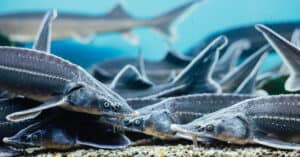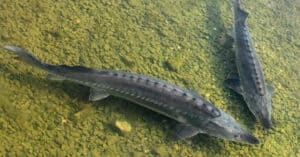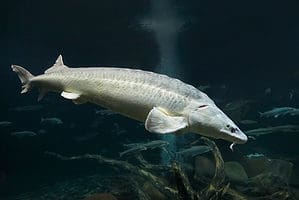Sturgeon are large fish found only in the Northern Hemisphere, and they get very old. Some individuals are well over the average life expectancy of a human being. How old is the oldest sturgeon ever?
What is a Sturgeon?

There are many types of sturgeons.
©Oregon Department of Fish & Wildlife, CC BY-SA 2.0 <https://creativecommons.org/licenses/by-sa/2.0>, via Wikimedia Commons – License
The name sturgeon refers to any one of 27 species of bony fish in the Acipenseridae family. These fish are sometimes huge at over 2000 pounds.
Beluga sturgeons are the largest at up to 24 feet in length, while sterlets are the smallest at 3 feet long. All of them have primitive bony sections named scutes instead of scales. Because of this, sturgeon meat and caviar are not kosher foods in Jewish culture.
According to the IUCN Red List, 85 percent of sturgeon species are endangered due to overfishing, mostly driven by the caviar industry. Some sturgeon, like Alabama sturgeons, haven’t been spotted in years.
Sturgeons are bottom feeders that chow down on small fish, shellfish, worms, and crustaceans. Sturgeons do not hunt with their eyes or trap prey in their toothless mouths. They suck food in and swallow it whole, with the largest individuals gulping up entire salmon.
Sturgeons have skeletons that are almost entirely made of cartilage. This type of skeletal structure is usually associated with primitive evolutionary states. In sturgeon, however, their current skeleton’s cartilaginous nature evolved after their ancestors’ bony version evolved.
While sturgeon do spend some of their time in the open ocean, they’re usually spotted in large estuarine or riverine environments. An example of prime systems for sturgeon is the Sacramento-San Joaquin River system in California and the Rhine River system in Europe.
Sturgeon have extensive ranges in many river systems in the Northern Hemisphere. Most migrate between saltwater and freshwater environments a few times during their long lives to spawn though some live solely in freshwater sources like lakes. While no sturgeon naturally occur in the Southern Hemisphere, there are efforts to farm the fish in South Africa and Uruguay.
How Old is the Oldest Sturgeon Ever?
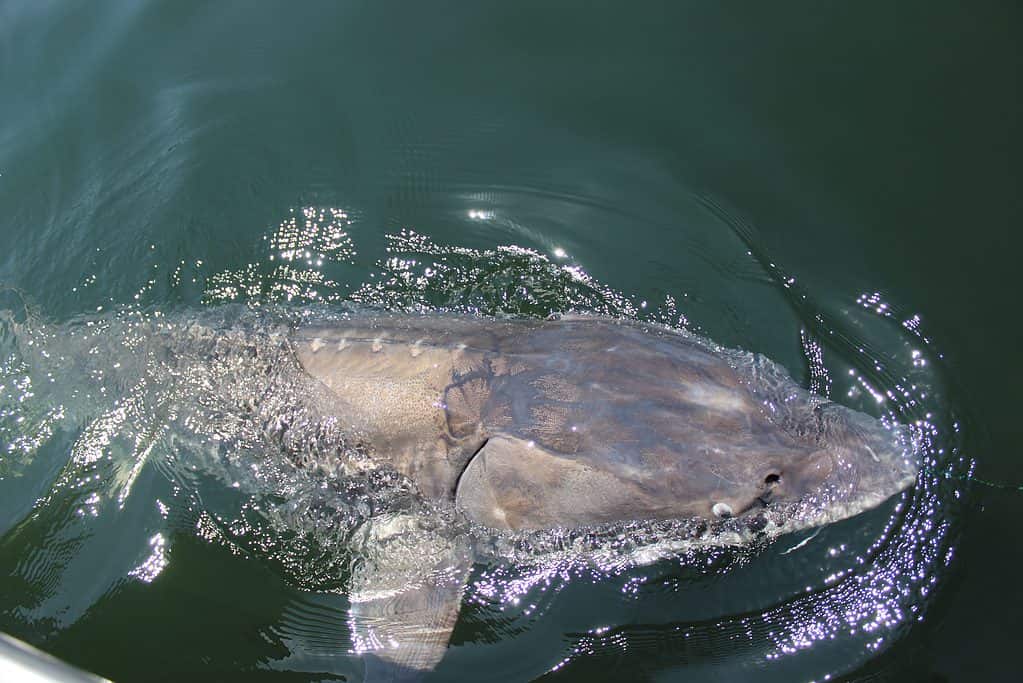
The oldest sturgeon ever was 110 years and was a white sturgeon.
©Leah.Zastrow/Shutterstock.com
The oldest sturgeon ever was a white sturgeon that was about 110 years old. It was also 10 feet long and weighed over 700 pounds. It was caught on Father’s Day as part of a catch-and-release trip with River Monster Adventures on the Fraser River in British Columbia, Canada.
The two anglers who caught the fish, Mark Boice and Steve Ecklund, had never been sturgeon fishing before the trip that led to their big catch. The fish put up a massive fight, and it took over 2 hours for the fish to tire out so it could be reeled in and dragged close to shore. It was tagged for future study by the Fraser River Sturgeon Conservation Society and released back into the wild.
Catching large and old sturgeons on the Fraser River in Canada is not uncommon. On March 6, 2022, Yves Bisson caught a 10-foot sturgeon weighing around 600 pounds. It was believed to be about 100 years old.
Another of the oldest sturgeon ever was a white sturgeon that was 103 years old. It was found in the Sacramento-San Joaquin system in California. As a comparison, the average sturgeon lives up to 60 years.
The importance of sturgeon to humanity is as old as fishing itself. In 1324, King Edward II of England declared the sturgeon to be a royal fish because it was so valuable. To this day, the law states that the monarchy of the United Kingdom may seize any sturgeon caught in UK waters as their personal property.
Are Sturgeon As Old As the Dinosaurs?
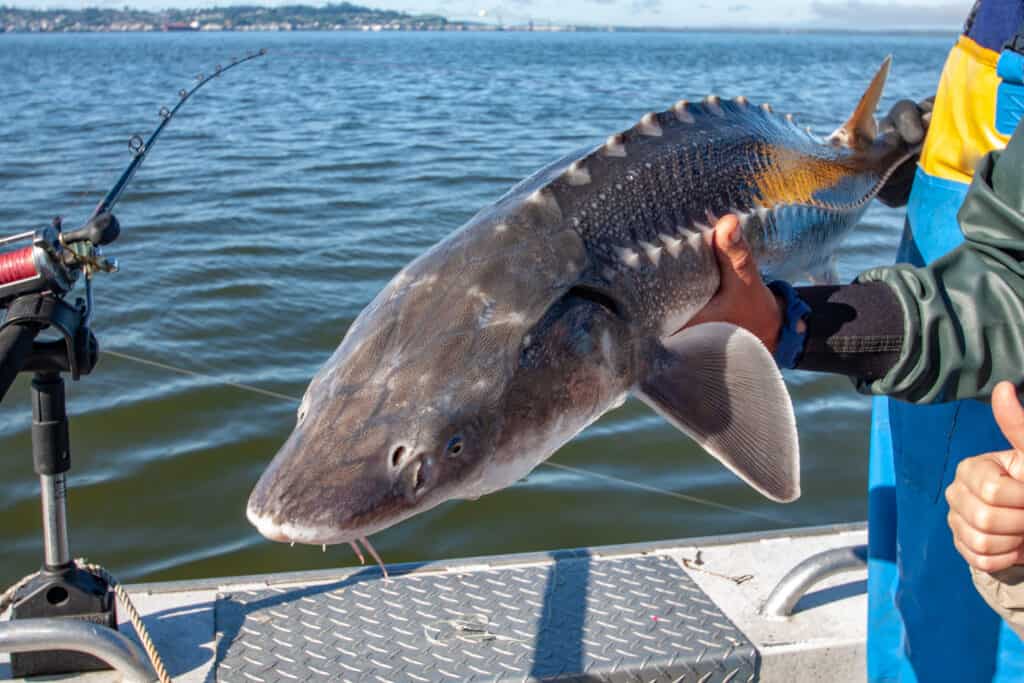
Sturgeons can grow over 14 feet long.
©CSNafzger/Shutterstock.com
Yes, sturgeon are as old as the dinosaurs. They evolved into existence about 200 million years ago. There used to be an abundance of sturgeon however, overfishing has dwindled their numbers.
With the ability to reach 20 feet in length, some sturgeons are super-sized, like a few of the most famous dinosaurs. Recently, a huge Atlantic sturgeon spotted on the Hudson River was over 14 feet long, and white sturgeons in the Pacific often surpass this. While huge water reptiles existed in earth’s oceans during the time of the dinosaurs, there were never any fully aquatic dinosaurs.
Sturgeons are considered living fossils since they’ve remained relatively unchanged on the planet for millions of years. Horseshoe crabs and Ginkgo biloba trees are other examples of living fossils.
What is the Oldest Fish in the Great Lakes?
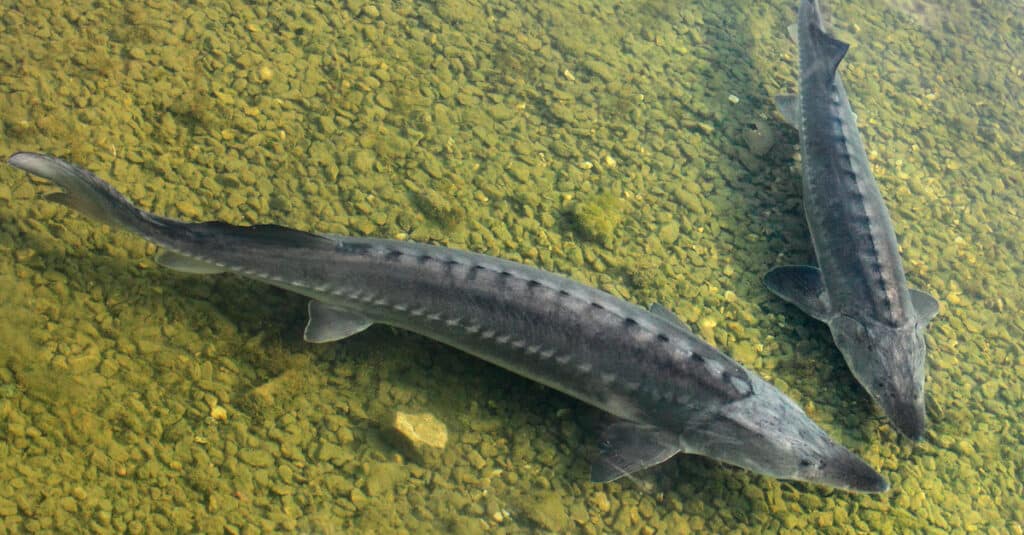
The Great Lakes is home to lake sturgeon.
©Kletr/Shutterstock.com
The oldest fish in the Great Lakes in the United States are lake sturgeon. There are rumors that the lake sturgeon in the Great Lakes live over 150 years though this is unsubstantiated. Most individuals live a little over half of a century.
These specific sturgeon sometimes weigh up to 200 pounds and are often over 6 feet long. They’re also referred to as rock sturgeon. While these huge fish aren’t aggressive to humans, they do sometimes jump out of the water and slam into boats.
They’re found throughout North America’s Great Lakes and other aquatic habitats. They’re also found in the Mississippi River and its tributaries. The Hudson Bay is another hotspot for lake sturgeon.
A sturgeon’s age is determined by its size since these fish never stop growing throughout their entire lives. This means that the largest fish are also the oldest.
Since female lake sturgeon grow slower and get larger than their male counterparts, they also live considerably longer. Almost all specimens that are over 30 years old are female sturgeon.
It’s believed that giant lake sturgeons may have inspired tales of monsters on the Great Lakes for centuries. One such monster that may be attributed to huge sturgeon is the Lake Erie Monster named Bessie.
Sea lampreys are a huge problem in the Great Lakes, posing a threat to lake sturgeon populations. These lampreys are invasive and prolific, devastating to local fish communities since one individual destroys up to 40 pounds of fish yearly. This, along with climate change, overfishing, and pollution, has driven the lake sturgeon population to historic lows.
Up Next:
- ‘Living Dinosaur’ Returns to Georgia After 50-Year Absence
- Paddlefish vs. Sturgeon: What Are Their Differences?
- Biggest in the World? Fishermen Discover a Fish as Big as a Chevy Suburban
The photo featured at the top of this post is © CSNafzger/Shutterstock.com
Thank you for reading! Have some feedback for us? Contact the AZ Animals editorial team.



